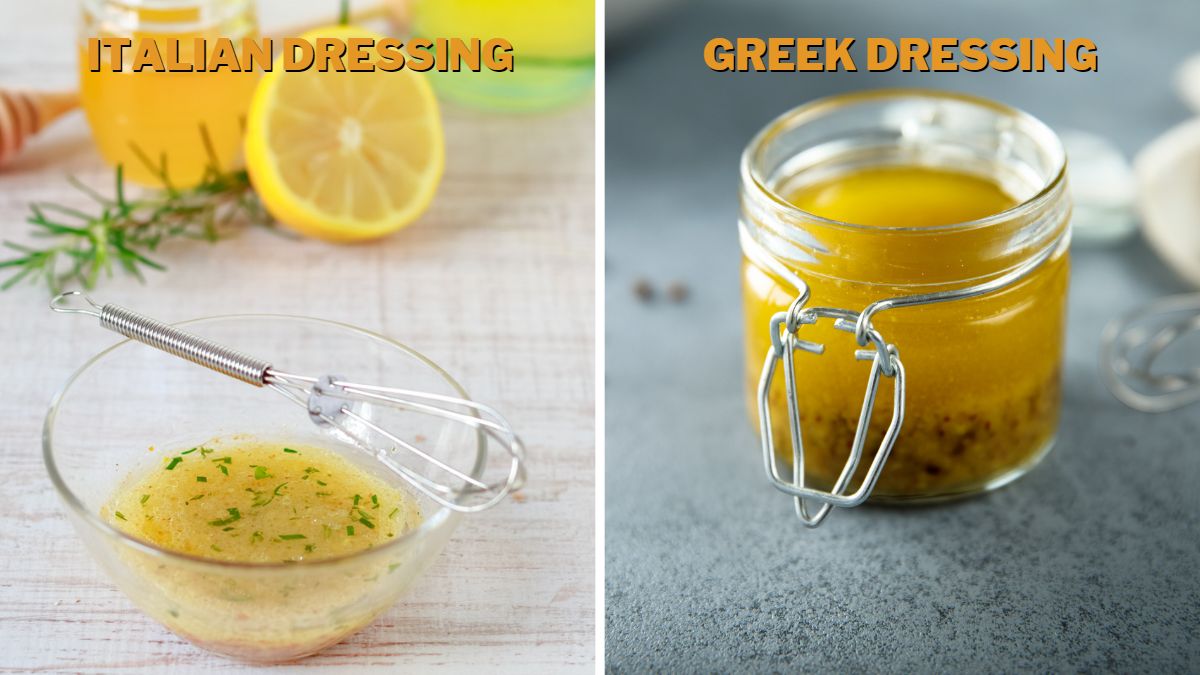Greek vs. Italian Dressing: Differences

Both delicious and versatile, Greek and Italian dressings are very famous and frequently used in restaurants and people’s households. Moreover, the recipes call for everyday ingredients you probably have around your kitchen, which makes people love them even more. However, these are two different dressings that people tend to confuse as they seem and taste similar. So, what are the differences between Greek and Italian dressings?
Greek dressing is made of olive oil, dried oregano, garlic, red wine vinegar, lemon juice, and Dijon mustard. Italian dressing contains white wine vinegar, garlic, lemon juice, Dijon mustard, and optionally honey. The difference in the ingredients results in slightly different flavors.
Since Italian and Greek dressings are two separate, they result in different flavors, which is most noticeable when combined with other ingredients, such as salads or meat. Therefore, in the following paragraphs, I will explain the differences between Greek and Salad dressings and hopefully help you when you decide which one to use.
Greek vs. Italian Dressing: Differences
Greek and Italian dressings are both vinaigrettes and can be used as a marinade in addition to their primary purposes, i.e., dressings.
Although they have similar flavors, they dress differently with their own markings. They use different ingredients, which results in different flavors and nutritional values. Also, the ingredients they use that are the same for both are used in different amounts for each dressing, which results in different nutritional values.
Ingredients and Preparation
Greek and Italian dressings use similar ingredients, but not identical and in different amounts. Greek dressing is made with olive oil, red wine vinegar as the base, Dijon mustard, minced garlic, and lemon juice as the main flavor-giving ingredients, and dried oregano as the key ingredient. Salt and pepper are compulsory parts of both Italian and Greek dressings.
The dried oregano gives Greek dressing the Mediterranean dimension it is so famous for. It is smooth but not creamy, and you can use it as a marinade and a dressing.
The main ingredients in Italian dressing are white wine vinegar and lemon juice, the base ingredients. Minced garlic is also a part of Italian dressing, Dijon mustard, chopped bell peppers, and, optionally, honey.

Italian dressing sometimes contains dried herbs, vegetable oil, and corn syrup, which are variations of the classic Italian dressing.
The preparation method is the same for both Italian and Greek dressings. Everything is mixed in a bowl and stirred until the ingredients homogenize.
The amounts are often added by intuition, but Italian dressing generally has less vinegar and Dijon mustard than Greek dressing. Also, Italian dressing has more lemon juice than Greek dressing.
Taste
Because it uses olive oil and red wine vinegar as a base, Greek dressing is a little more intense and heavier than Italian dressing. Not that this means it is heavy, but it is heavier than Italian dressing.
It tastes like oregano with a slight tang from the Dijon mustard. It has a discrete citrus freshness from the lemon juice that, combined with the garlic, intensifies the rest of the included notes in the dressing.
Italian dressing is a little sharper and more intense than Greek dressing. It is fresher and edgier. The white wine vinegar and lemon juice base sets the tone for an intense mouth-watering flavor. The garlic and Dijon mustard are noticeable, giving the dressing a slightly tangy dimension.
The chopped bell peppers impact the texture more than the taste, so they inject the Italian dressing with playfulness and color. The optional honey, some might add, tones down the overall sharpness of the flavor and balances everything out.
Nutrition
Nutrition-wise, both dressings are similar since they contain similar ingredients. However, there are some slight differences in this aspect too. Namely, due to the olive oil, Greek dressing is slightly fattier and more caloric than Italian.
Italian dressing has slightly more sugar than Greek due to the more significant amount of lemon juice. They are both low in carbs, sodium, and protein, whereby Italian dressing is fat-free. [1] [2]

Uses
In addition to being used as salad dressings, both Italian and Greek dressings can be used as marinades for chicken or pork and seasonings for dishes containing rice or beans. You can also use them for pasta seasoning, spinach salad, or with any other leafy vegetable.
